Donald Trump has an “An America First Energy Plan.”
In it, he calls for “American energy dominance,” which he sees as a strategic, economic, and foreign policy goal. He seeks “American energy independence”—which he defines as being “independent of any need to import energy from the OPEC cartel or any nations hostile to our interests.” According to his energy adviser, Rep. Kevin Cramer (R-ND), this acknowledges that we will still use oil from our friends like Canada and Mexico and that due to refinery configurations, there will likely continue to be oil imports and exports.
He understands that our amazing American energy resources offer the United States tremendous wealth and economic advantage. In his May 26 speech in North Dakota, addressing untapped oil and gas reserves on federal lands, Trump exclaimed: “We have no idea how rich we are. We want to cherish that wealth.” In comparison, he pointed out that Hillary Clinton wants to lock up “trillions in American wealth” while her “poverty-expansion agenda” enriches her friends and makes everyone else poor. In the speech, Trump pointed out to the audience, largely made up of people from the oil and agriculture industries: “If Crooked Hillary can shut down the mines, she can shut down your business, too.”
Trump will move away from government-central planning efforts and return authority back to the states—an idea that has made it into the Republican Platform. His plan has three main components. Under a Trump administration there will be big changes in climate policy, regulations, and the management of federal lands.
Climate policy
Trump has pledged to “cancel the Paris Climate Agreement and stop all payment of U.S. tax dollars to U.N. global warming programs.” He says such policies are evidence of America bending to benefit other nations at a cost to the U.S. Once the “draconian climate rules” are eliminated there is no rationale for imposing a “job-killing cap-and-trade” scheme or to keep extending the subsidies for wind and solar. He is not opposed to wind and solar energy, and in fact, wants to “get bureaucracy out of the way of innovation so we can pursue all forms of energy,” but he doesn’t support the idea of “the government picking winners and losers.” Like other energy sources, once the subsidies expire, the wind and solar industry would benefit from typical business tax deductions and deferments.
Regulations
Trump’s agenda calls for “Regulation reform that eliminates stupid rules that send our jobs overseas.” He knows that “costly regulation makes it harder and harder to turn a profit.”
Cramer told me we can expect Trump to roll back a lot of Obama’s regulatory overreach and take a different approach toward rules, like the Waters of the U.S. and the Clean Power Plan, that are currently under a court-ordered stay.
Coal miners have come out en masse for Trump because of his promise to “save the coal industry.” I asked Cramer how Trump planned to do that. He told me that while coal-fueled power plants that have already been shut down or converted to natural gas will not likely be reopened, a Trump administration can save what’s left and stop the bleeding by not artificially punishing the industry through regulation.
In short, Trump explained: “Any future regulation will go through a simple test: is this regulation good for the American worker? If it doesn’t pass this test, the rule will not be approved.”
Federal Lands
In his speech, Trump reminded people that President Obama has halted leasing for new coal mines on federal lands and aggressively blocked the production of oil and natural gas by closing down leases and putting reserves off limits. He pointed out that these resources are an American treasure and that the American people are entitled to share in the riches.
As a part of his 100-day action plan, Trump has promised to “lift moratoriums on energy production on federal areas.” Instead of slow-walking permits or being passive-aggressive with the permitting process, he’ll order agencies to expedite exploration, drilling, and mining permits.
Trump has said he intends to “trust local officials and local residents.” This idea will be played out in his approach to the management of federal lands—which Cramer explained will be more of a state and federal partnership where states will have a much greater say regarding the their land use. This includes the regulation of hydraulic fracturing.
We’ll see this same philosophy played out in the designation of national monuments—something the Obama administration has abused by turning the ability to designate national monuments into a land grab. His monument designations often prevent productive use of the federal lands—such as agriculture or mineral extraction. The GOP platform committee adopted language that empowers states to retain control over lands within their borders. New monuments will “require the approval of the state where the national monument is designated or the national park is proposed.” As a result, Cramer told me: “We will not see a lot of new federal lands.”
Additionally, Trump would “ask TransCanada to renew its permit application for the Keystone pipeline” and he has long been a supporter of nuclear power.
Trump’s energy plan is a turn toward realism, based on the fact that our American energy abundance can allow for shared prosperity, better schools, more funding for infrastructure, higher wages, and lower unemployment. Isn’t that what making America great again is all about?
The author of Energy Freedom, Marita Noon serves as the executive director for Energy Makes America Great Inc., and the companion educational organization, the Citizens’ Alliance for Responsible Energy (CARE). She hosts a weekly radio program: America’s Voice for Energy—which expands on the content of her weekly column. Follow her @EnergyRabbit.

COMMENTS
Please let us know if you're having issues with commenting.